| Cook
Rendezvous enters the record book |
Robert
Leverett |
|
Apr
25, 2005 06:10 PDT |
ENTS:
The third ENTS rendezvous at Cook Forest is
history now. The event
was wet and a little on the cold side, but it was GREEAAAT. A
special
thanks goes to Dale and DCNR for putting it together
administratively
and a very special thanks goes to all the
presenters/participants.
Will and Ron made a successful climb up the
Karl Davies black cherry
and we taped it to 137.3 feet in height. Seeing Will high up in
the
wispy top of that leafless tree emphasized its height.
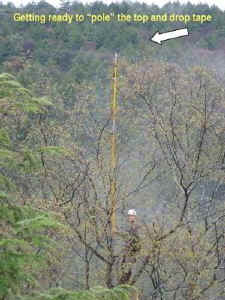
Getting ready to pole the top and drop tape on Karl
Davies black cherry -
photo submitted by Will Blozan |
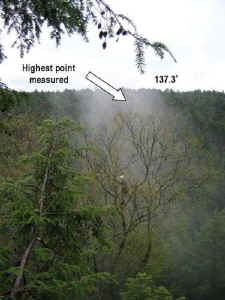 Highest point on
Karl Davies black cherry at 137.3
feet -
photo submitted by Will Blozan |
On a forest walk earlier on Saturday, we also
remeasured a couple of
the biggest Cook Forest pines including the great Seneca Pine.
At a hair
over 173 feet (I got numbers ranging from 172.9 to 173.3), the
pine is
one awesome tree, but then so is the Cook Pine at 162.2 ft tall
and 12.4
ft around. Cook has 27 pines over 160 feet tall.
We measured an American beech to slightly over
127 feet to become the
new champion for Cook Forest. But we lost a little on the black
cherry.
So overall we lost some and gained some and when the counting
was over,
Cook's Rucker Index inched up to 136.02. I have absolutely no
doubt that
there are taller beech trees. I expect there is a half dozen
over 130
feet.
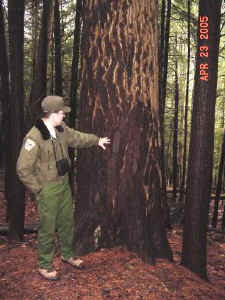 photo by Scott Wade
photo by Scott Wade
What was especially great this rendezvous was
that our young friend
Jess Riddle was able to make it up from South Carolina. John
Eichholz
Scott Wade got their first looks at Cook Forest. So we had quite
a
measuring crew. The full list was:
Dale Luthringer
Will Blozan
John Eichholz
Jess Riddle
John Knuerr
Gary Beluzo
Susan Scott
Holly Post
Scott Wade
Bob Leverett
The lectures by Lee Frelich and Tom Diggins
were great as always. We
held a tree measuring workshop and had excellent walks in the
woods. We
gathered at the Trail's End restaurant for meals.
Well, others may want to add their
observations so I'll stop here. We
just wish more of you could have attended.
Bob
Robert T. Leverett
Cofounder, Eastern Native Tree Society
|
| Cook
Forest Rendezvous synopsis |
Dale
J. Luthringer |
| May
02, 2005 19:03 PDT |
Ents,
I'd like to take this opportunity to thank all the Ents that
came over
to Cook Forest for the ENTS Spring Rendezvous. I apologize for
not
posting earlier, but I remember someone asking me at breakfast
on Sunday
what I would do when everyone left... My reply was simply one
word,
"sleep". That's exactly what I did. Since I just came
out of
hibernation, I thought it would be a good time to give a run
down of the
various events that took place.
First off, the event really started Thursday evening with the
arrival of
Will Blozan, Ron Busch, and the illustrious Jess Riddle. It was
great
to see Will (Batman) and Ron (Superman) again, but it was my
first time
to meet in person Jess (Boy Wonder) Riddle. Let's just say they
wasted
no time in measuring trees once they got to Cook Forest.
After an 11hour ride up from South & North Carolina, they
were quite
eager to take a look at the Davies Black Cherry, Seneca Pine,
Longfellow
Pine, and Cook Pine. They didn't really have to twist my arm
though, I
was more than willing to get out of my office for the first time
in
weeks.
We first took a look at the Davies Black Cherry, located not far
off of
Forest Road. Once Will and Ron took a look at its crown, they
dubbed it
a go for Saturday. We then spent some time trying to pin down
its
height. The best measurement we could get was from directly
underneath
at slightly over 138'. The best I got for this tree was right at
140'
about a year and a half ago, but that was before multiple wind
events.
Last Fall the best I could get was a bit over 137', but I wasn't
sure I
had the same window. This tree is a bugger to measure at a
distance
away from the tree. The interlocking branches and multiple
canopy
layers make it quite a challenge.
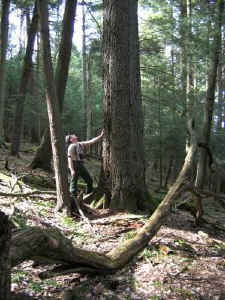
Karl Davies cherry base -
photo submitted by Will Blozan
We were still hoping to go to 140' after the tape drop on
Saturday, but
it was not meant to be. Tape drop on Saturday put it at 11.4ft
CBH x
137.3' high. Ron had a great view of the cherry's crown from the
top of
a nearby hemlock tree as he guided Will's pole placement in VERY
wet
weather.
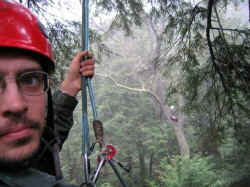
Ron Busch with Will Blozan in the background -
photo submitted by Will Blozan
Thankfully, it was not a torrential downpour at the
time of
the climb. It rained to varying degrees right up to the climb,
then let
off a bit just in time. Even though we lost some height on the
Davies
Black Cherry (Bob kept us legal as he marked the baseline
measurement),
it still is the tallest documented black cherry confirmed by
tape drop
in the entire Northeastern US! Chalk up another tall record
tree
climbed and taped by the talented Will Blozan.
After scoping out the Davies Black Cherry, we had to show Jess
some of
the magnificent pines in the Forest Cathedral. So, off we went
for a
short 3 mile jaunt to view the Longfellow Pine, Seneca Pine, and
Cook
Pine. Will, Jess, and I put the Longfellow Pine now at 11.1ft
CBH x
182.1ft, which gave it a slight nudge up from my previous 182ft
measurement in early Fall 2004.
We then breezed past the Seneca Pine, which continues to decline
but is
still not willing to give up the ghost. We then headed over to
the Cook
Pine a good "1/2 mile away" I told them... Well, I
think it turned out
more like a good mile away. Will now puts the Cook Pine at
12.4ft CBH x
162.3. The last time I measured it was over a year ago with the
best I
could get then at just over 161ft. I believe the Cook Pine is my
most
favorite old growth pine. This tree has incredible character
with a
twisted top and arm-like limbs, one on each side of the trunk.
Next, the Northeastern U.S. height record white oak was close by
so we
thought we'd try to remeasure it. This is another awful tree to
measure. Shooting straight up from underneath with all the
leaves off I
was able to confirm a new height at 10.6ft CBH x 127.3ft high.
We then headed out to the Trails End Restaurant to replenish some lost
calories and get ready for Friday.
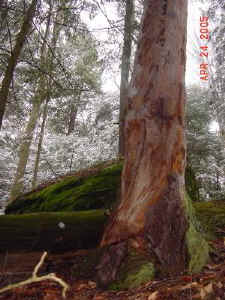
photo by
Scott Wade
We started Friday off at 1000am at the Park Office with Will,
Ron, Jess,
and I. We also picked up Dr. Lee Frelich who made it in from
Minnesota
late Thursday night. The agenda for the day was to head over to
Ander's
Run to take a peak at the magnificent Cornplanter Pine and maybe
head
over to Heart's Content. Well, Heart's Content was not meant to
be for
this trip. On the way to Anders, Will spotted a huge moss
cypress
growing off the road at the Buckaloons Recreation Area... who
knows HOW
many times I passed this tree and didn't see it. Will just has
the eye
for these things. Will, my best excuse is that it was hiding
behind
those 120ft class Norways you found there too... Speaking of
those
Norways, can you give me the stats you got for the trees you
measured at
Buckaloons? It would be nice to eventually get a RI for that
site.
Buckaloons Recreation Area turned out to be an unexpected treat.
Turns
out the moss cypress is the 2nd tallest that ENTS has documented
before... is that right, Will? It may very well turn out to be
the next
PA state champ once we take a closer look at the stats. Will got
6.1ft
CBH x 83.5ft high x 24ft crown for a total of 162.7 points. The
cypress
was most likely planted by descendents of General Irvine who
started a
plantation in the area in the late 1700's after the
Revolutionary War.
Will believes the cypress will most likely go over 150 years
old. What
an AWESOME tree!
We also measured some other nice trees in the area. A nearby
European
larch went to 7.4ft CBH x 110.5ft high which turns out to be the
2nd
tallest measured in PA. While Will was measuring the cypress, he
also
picked out a massive N. red oak growing across Brokenstraw
Creek. Turns
out it was most likely an old fused double but high up the trunk
(>~10ft) at 17.9ft CBH x 104.3ft high (underneath).
Lee spied a nice honey locust nearby too. Turns out to be the
first
ENTS measured in PA at 4.3ft CBH x 85ft high.
Anders
Run Gallery
We then reluctantly hopped back in the car to head the short
distance
over to Anders Run before we ran out of good weather. You should
have
seen the snide look Will gave me as I said, "Come on, lets
get to the
good stuff!". But, once we got to Anders Run Will keyed up
one of BVP's
famous quotes, "Smells like big timber!". He almost
jumped out of his
seat when he saw the Anders Run Norway Spruce towering above the
other
trees in the river flat below.
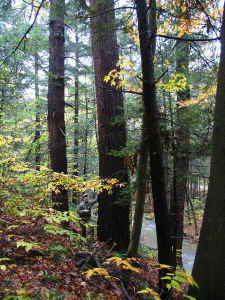 Cornplanter Pine Base
Cornplanter Pine Base
We parked a short distance away from the Cornplanter Pine. It is
easily
viewed about 80 yards off the west side of the road, across the
creek,
and just below the the apex of the steep part of the hill. The
Cornplanter is in a serious state of decline most likely due to
an
onslaught of turpentine beetles as noted from their boreholes at
the
base of its trunk. The Cornplanter now stands at 13ft CBH x
167.1ft
high. This tree is MASSIVE! Will believes it may go to 1200
cubes, but
may be unclimbable in a couple of years due to its thinning top.
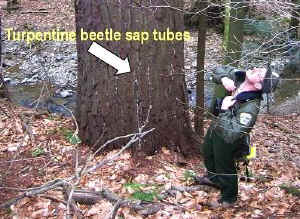
Cornplanter
Pine base -
photo submitted by Will Blozan
We then hopped back in the car and parked near the Allegheny
River to
take a look at some of the river bottom trees of this natural
area.
Of course, we first had to check out the record Norway spruce,
but we
first past a very nice Nordmann fir.
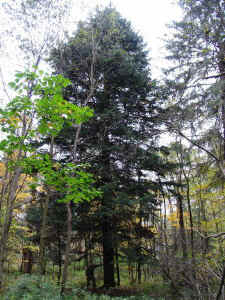 Nordmann Fir
Nordmann Fir
I must admit, I previously
mis-identified this tree as a balsam fir, but with Will's wide
inexhaustible tree identification expertise, he quickly put me
back on
track, although it did take me awhile to figure out the correct
spelling
of the tree. The Nordmann fir is not the largest in the state,
but may
be a state co-champ when all is said and done. It stands at
6.8ft CBH x
91.8ft high as of Fall 2005.
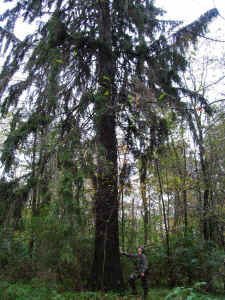 Norway Spruce
Norway Spruce
The PREVIOUS Eastern U.S. height record Norway spruce was very
close by.
Will's recent find of a ~135ft Norway now beats it, but the
Anders Run
Norway is still the 2nd tallest documented in the East at 10.2ft
CBH x
132.7ft high. Gorgeous tree. I now must return and get crown
spreads
for this Norway and the Nordmann fir.
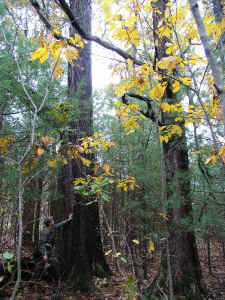 Swamp White Oak champion
Swamp White Oak champion
On the way out, we decided to go past some nice swamp white
oaks. One
in particular is at least the tallest documented in the
Northeast at
10.4ft CBH x 111ft high. Another fine specimen nearby went to
11.6ft
CBH x 107.6ft high. There were some very old oaks in this area
including swamp whites, black (12.9ft CBH x 84.1+ft high), and
white
oaks (15.3ft CBH x 87.1+ft high). We timed the weather just
right.
Just as we were heading back to the car a short distance off,
the
weather turned sour and stayed like this the rest of the entire
weekend!
Weather forecasts for the weekend did not show promising weather.
It
started out with rain in the 50's on Saturday, and just got
colder as
the day went by... 30's and sleet/snow by Saturday evening. We
started
Saturday morning off at the Log Cabin Inn with a fine
presentation by
Bob Leverett on measuring trees for science and sport. We then
headed
outside to hone our skills.
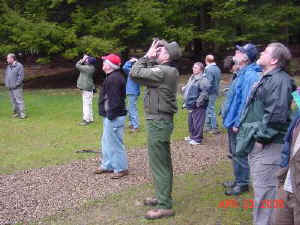 photo by Scott Wade
photo by Scott Wade
We took a short break when we were done, then headed up into the
Forest
Cathedral to scope out the Longfellow Pine, Seneca Pine, and
Cook Pine
with the rest of the public and ENTS members. Will, Jess, and
Ron
headed out to set-up the ropes for their climb up the Davies
Black
Cherry later that afternoon.
I really didn't think we'd find any new record trees on our trip
up to
the Indian Springs area in the Forest Cathedral. But... I hadn't
previously experienced an Am. beech as it was being 'Eicholzed'!
Needless to say that John and Bob spied a couple of super Am.
beech's
that they soon scoped out to 8.1ft CBH x 124.4ft high (tied
Will's old
Am. beech park height record) and a new beech park height record
nearby
at 6.2ft CBH x 124.6ft high!
I should've known better, but I thought that this was all the
better it
was going to get for beech that day. Little did I know that John
would
soon be at work again near the Davies Black Cherry that
afternoon,
Eicholzing not just a new Am. beech park height record, but a
new state
height record as well at 127.5ft high!
After the climb, the ENTS crew gathered at the Trails End for
our
traditional evening meal. Meanwhile, behind the scenes Gary
Beluzo was
busily getting the evening presentations ready. Gary got
everything
working perfectly except for one problem... sadly, his computer
crashed
and he was not able to present his highly anticipated GIS based
program.
I'm afraid that we'll all just have to be in suspense until the
Forest
Summit in Holyoke this Fall. I know he was really disappointed,
but at
least all that hard work in preparation over the last month is
now done
and will make for a superb program in October or future
presentation at
Cook Forest.
Bob Leverett lead the evening presentations off with a wonderful
overview of ENTS, followed by Dr. Chuck Williams of Clarion
University
with his presentation of old growth stream ecosystems. Dr. Tom
Diggins
of Youngstown State University was next with his intriguing program on
forest preserves of the Lake Erie Gorge Region. Then, our
keynote
speaker, Dr. Lee Frelich, Director for the Center of Hardwood
Ecology at
the University of Minnesota, proceeded to blow us away with some
incredible new findings on derechos. It's amazing that he's even
here
to tell us some of the stories of the close encounters he's had
with
devastating storms over the years.
Of course, all the speakers couldn't leave without a small memento
of the
event. Bob Leverett received a small pocket sized chalkboard so
that he
will always be prepared to explain the finer intricacies of the
sin-top +
sin-bottom method to various skeptics in the field.
Gary Beluzo received a toy "smart phone" to help us
keep track of him
with his ever-changing cell phone numbers.
Will Blozan received a small "cap bomb" to use as a
plumb bob for his
next tape drop measurement. At the least, it should keep the
rest of us
out from under him the next time he climbs a tree... except for
Bob
though. Will, we might have to go with a higher charge to keep
low
pressure Leverett out of the way.
Chuck Williams received a whistling nerf vortex to tie his
measuring
tape too the next time he has to get his measuring tape across
the log
and to his partner for his next downed woody debris study.
Tom Diggins received a whoopee cushion to help combat gaseous
little boys
that have seemed to gravitate to him at the last two ENTS
events. Well,
he at least says he'll get some use out of it in the lab... now
there's
some lucky students!
Last, but certainly not least, Lee Frelich received his first
donation
of a "million bucks" to help further his research.
Yes, I know it was
only fake "Art Linkletter" money, but it's the thought
that counts. Too
bad thoughts can't pay the bills though.
Even though the weather was cold and rainy for the majority of
the events
on Saturday, I believe the programs still went off quite well. I
am
very thankful and indebted to everyone who came from all corners
of the
Eastern U.S. and put so much into making this unique event a
success.
The Ents are truly a very special group of people. I am very
honored to
have a small part in bringing everyone together. Cook Forest
State Park
is extremely grateful for all the work that the Eastern Native
Tree
Society has done to put Cook Forest on the map as one of the
premiere
parks to visit in the Eastern United States.
Your Most Humble & Obedient Servant,
Dale Luthringer
Environmental Education Specialist
Cook Forest State Park
|
| More
on the rendezvous |
Robert
Leverett |
|
Apr
25, 2005 07:25 PDT |
ENTS:
After the 3rd rendezvous at Cook, it would be easy to begin
taking
such events for granted. However, some of us remember the early
days
when knowledge about the Cook Forest big trees was of an
undifferentiated type, i.e. one big tree is like another and
local
managers knew next to nothing about any Cook's trees. The
management
back in the early 1990s had a patronizing attitude toward Cook's
great
trees and the general public was left to feel ambivalent in some
ways.
In the prevailing mindset, one liked all trees and paid homage
to the
forest gods, but one didn't tend to individualize the trees -
unless
some official body might single out a particular tree for
special
attention. I am reminded of trees like the former Douglas
MacArthur pine
of Wisconsin which become famous because it was singled out, but
other
worthy trees staid anonymous. Well, that isn't the ENTS way.
 photo by Scott Wade
photo by Scott Wade
Today in Cook Forest we have a number of exceptional trees
identified
and individualized including the following:
1. Longfellow Pine (182.0, 11.3) tallest tree in Northeast
2. Seneca Pine (173.1, 12.5) PA champ
3. Cook Pine (162.3, 12.4)
4. Feather Duster Pine (174, 11.2)
5. Jani Pine (171.2, 10.1)
6. Karl Davies Black Cherry (137.3, 11.4)
There are other Cook Forest trees and undoubtedly will be many
more.
But what if ENTS hadn't taken a special interest in the Cook
Forest
trees and Dale Luthringer weren't Cook's shinning star? Then
Cook's
great trees would enter the club of the nondescript. Cook's fine
trees
deserve to be honored and honor them we did, this past weekend.
Bob
Robert T. Leverett
Cofounder, Eastern Native Tree Society
|
| Cook
Forest, more |
John
Eichholz |
|
Apr
25, 2005 20:27 PDT |
ENTS:
The trees of Cook forest may have been honored by the attention
we have
been able to bring to them, unlike many of their fellow trees
elsewhere. I also feel honored to have had the opportunity to
spend
time in their midst. Cook Forest is surely a special place, one
where I
could spend many weeks exploring, measuring, discovering.
The weather was unseasonably cold, with light snow and rain for
most of
the weekend. This unfortunately cut into the aggregate tree
measuring
time we could deploy to the site. I feel I barely got a survey
of the
forest, let alone the canvassing the site deserves by the full
ENTS
crew. Except for the programmed walk along the Longfellow, Joyce
Kilmer
and Indian trails, I focused on the environs of the Davies
Cherry tree
and the stream valley that runs along the Hemlock Trail, a
sliver of the
site.
The site record for American Beech, 124.6'h, was reached and
briefly
held by one of a pair of fine specimens we measured in the
Forest
Cathedral area on the Joyce Kilmer trail. In the same immediate
area
was a fine Eastern Hemlock at 135.9'h. Several other hemlock
between
there and the Cook Pine topped 130'. Another hemlock below the
Longfellow trail between the Indian trail and the Ancient Forest
trail
topped 137'h. Sorry, I don't have cbh for most of these, as I
lost my
tape measure in Philadelphia (another story to come later.)
The site record for beech was broken again later in the day by a
nicely
formed tree very close to the Karl Davies cherry. Will noticed
the tree
from high atop the cherry, and I noticed it while they were
packing up
their equipment. Several people measured the tree, and we can
safely
put the height at between 127' and 128'. I got 127.3' on one
top, and I
think we averaged out to 127.5'. Two other tops reached over
126'.
There were many candidate tops on this tree, but we think we got
some of
the tallest. This whole slope has of course spectacular black
cherry,
but also has many fine beech, some of which could top the 127'
mark.

Chestnut
Snag -
photo submitted by Will Blozan
The next morning, I spent some time along the Hemlock Trail,
which
follows a stream up from the road quite close to the
cherry/beech area.
I intended to look for more beech, but was immediately struck by
the
fine growth of birches. The setting was a beautiful old growth
and mossy
Hemlock forest, and the stream channel was filled with large
woody
remains. The first yellow birch I measured, right along the
stream,
came to 99.9'h, breaking the site record of about 92'. I also
found a
couple nice black birch on the south bank above the stream, one
of which
squeaked past the site record height at 107.9'. Farther upstream
on the
north bank were several nice yellow birch with older growth type
platy,
balding bark, lacking the fine curly nature of younger yellow
birch.
They were not that large in diameter. From a distance, they
appeared to
be black birch, except the bark was lighter. On examining the
root
flares, the golden, curly bark one expects was evident, and the
bark
plates were distinctly yellow. The tallest one measured 104.9'h
and
5.5'cbh, which I believe is a Northeast height record. Two other
yellow
beeches on this slope topped 103'. Other species present were
mostly
hemlock, with an occasional white pine, red maple, black birch,
cucumber
tree (one) and beech. Of the several beech in this valley, two
approached 120'.
Here is my list from this area:
species height cbh
Yellow Birch 99.9' 4.7'
Yellow Birch 99.1' 4.8'
Yellow Birch 104.9' 5.5' Northeast
height record
Yellow Birch 103.7' 4.3'
Yellow Birch 103.1' 4.7'
Black Birch 92.3' nt
Black Birch 107.9' 4.6' Cook
Forest record
Black Birch 101.6' 4.5'
American Beech 119.4' 4.9'
American Beech 118.9' 7.0'
American Beech 127.3' nt
(taken by others) Cook Forest record
Of course neither of the birches will add to the 10 species
Rucker
index, but if we extend the index to 25, well, that is another
story.
Thanks, Dale, for a very enjoyable weekend.
John
|
| Re:
Cook Forest |
wad-@comcast.net |
| Apr
26, 2005 08:51 PDT |
Will,
ENTS
Cook was awesome!! After we had breakfast on Sunday, I went back
into cathedral and did a little trail blazing up over the
mountain. It was so nice to be in the snow with the massive
trees and no noise from cars, airplanes, or people. Just the
wind in the tree tops and a lone woodpecker tapping away. I can
say that I was blown away by the tree heights and the
hospitality from Dale. It was nice to put faces with names, and
to see the Hyde Park crew again.
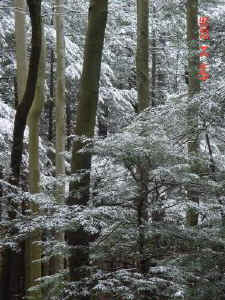 photo by Scott Wade
photo by Scott Wade
Scott
|
| More
ramblings on the meaning of Cook |
Robert
Leverett |
| Apr
26, 2005 09:29 PDT |
ENTS:
Before getting into the subject of this e-mail, let me say that
we
missed Ed Frank at the rendezvous. I presume the respiratory
ailment
that Ed is struggling with flared up again. Get well, Ed. We're
thinking
about you.
With the addition of John Eichholz's yellow birches and the real
possibility of compiling a significant number of American beech
trees in
the height range of 120 to 130 feet, once again I find myself
asking the
question: what is the true significance of our
discoveries/confirmations? Does it really matter if Cook's
Rucker index
tops 136; if there are 27 white pines over 160 feet, 5 over 170,
and 1
over 180; etc.? Does our knowing these heights and a multitude
of others
enhance our own personal enjoyment of Cook Forest or that of
others?
Well, of course, it doesn't impact many visitors in any
appreciable way.
Others like knowing that we (or somebody) is keeping track of
the stats.
A few take comfort in knowing a few numbers, and a tiny fraction
of
visitors savor the numbers.

Longfellow
Pine trunk -
photo submitted by Will Blozan
One might even argue that publishing the
statistics and making the
claims for them that we make is misleading. For how can we
really know
if John's new yellow birch is the tallest of its species in the
Northeast? Well, of course we can't know that. It is the tallest
we have
measured and across Pennsylvania there may be a scattering of
yellow
birches that beat the Cook Forest tree. We may never find one of
them or
we might find a cache of them.
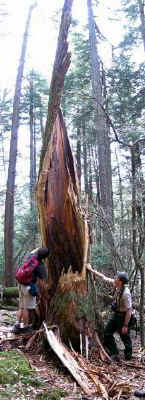
Record Cucumbertree Stump -
photo submitted by Will Blozan
With the above caveats acknowledged, I
maintain that it is important
to track the big/tall trees of special places like Cook Forest
and to
judiciously report on them. At the least, our site statistics
create a
context in which the big/tall trees of each property we survey
can be
evaluated in terms of their relative abundance or scarcity. At
the
least, we can identify what is rare and what isn't and since
scarcity is
often associated with value, our numbers highlight what has
value, or
potential value, that might otherwise fall through the cracks.
I remember talking to a past park supervisor
of Cook. It is difficult
to imagine how anyone of that position could have known so
little about
the Park. How could he properly advocate for Cook Forest? When
places
like Hearts Content and Tionesta were mentioned, he assumed Cook
Forest
fell below them in terms of significant trees. That pretty much
says it
all.
Bob
Robert T. Leverett
Cofounder, Eastern Native Tree Society
|
| Cook
Forest |
edniz |
| Apr
30, 2005 05:17 PDT |
Hello,
Just wanted to
say what a great experience I had at Cook Forest. I
love traveling into Western NY and PA. This gave me an
opportunity to do
both. It was a 242 mile trip for me. Although the weather wasn't
ideal, it
certainly could have been worse. I want to thank Will Blozan for
letting me
have a spare bunk and the hospitality that all of you showed to
me. I got
22 signatures in my "Guest Book", Tree by Jim Balog. I
is nice to have
faces I can attach to names now.
Ed Nizalowski
Berkshire, NY |
| Cook
Forest 2005 |
Will
Blozan |
| Apr
30, 2005 18:59 PDT |
Hello
ENTS,
Even though the weather was wet and cold for most of the event I
really
enjoyed the Cook Forest 2005 ENTS Rendezvous. I was especially
pleased to
have been able to climb the Karl Davies Cherry. Many thanks to
Ron Busch for
his assistance in rigging and photographing the climb! I was
able to get
some great shots of the Longfellow and Cook pines on Thursday
before the
rain set in. I will send a bunch to post to Ed soon. Ed, I am so
sorry you
weren't able to attend. Same for Ed Coyle. We missed you guys.

Cornplanter Pine Trunk -
photo submitted by Will Blozan
I hate to admit it but the highlight of the trip for me was
Anders Run. Not
that Cook was less than stellar; I just love exploring new areas
and seeing
new stuff. The demise of the Cornplanter Pine was a bummer, but
a
ground-based trunk modeling would be possible for a few more
years or a
climb within a few months. Maybe Ed Coyle could measure the
tree. Anyway,
the Norway spruce at Anders Run was SO AWESOME! Holy crap! And
at 132.7'
tall it looked to me just like a Sitka spruce in the PNW. [10'2"
X 132.7' Spread
we forgot to do but is likely close to 40'- it
is
huge!
] What a
beauty! And
the Buckaloons Park that someone-who-will-remain-unnamed drove
by a dozen
times without stopping. holy Norway spruce Batman! And then
tucked in the
120'+ spruce grove was a potential PA State Record and eastern
height record
(?) Chaemacyparis pisifera 'squarrosa' (moss cypress- 6'2"
X 84.2' X 24').
WOW! PA can grow some trees! AND we got to see swamp white oak
in the wild.
What an utterly beautiful species!
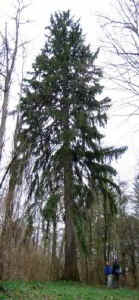
Ander's Run
Norway spruce -
photo submitted by Will Blozan
For me, seeing healthy hemlocks is always a treat, and those at
Cook Forest
are super vigorous. I used some shots from the cherry climb in a
presentation to about 160 people last night in Gatlinburg, TN. I
spoke for
an hour on ENTS and what we are doing. Those folks were floored
by our work
and glued to the slides. GO ENTS!
As mentioned by a few others, the ENTS gatherings are so special
when we can
connect faces to names. I was so please Jess Riddle could
attend, and I was
glad to finally meet Scott Wade, Ed Nizalowski and a few others
I can't
recall in this brief email. Good times were had and new
friendships and
alliances made. Many, many thanks to Dale for the organization
and
inspiration behind it all. But next time, we will bring a change
of clothes
for you! ;)
ENTS is growing in leaps and bounds!
Will Blozan
==============================================================================
TOPIC: Swamp White Oak
http://groups.google.com/group/entstrees/browse_thread/thread/8d5a13e74eeff428?hl=en
==============================================================================
== 1 of 3 ==
Date: Wed, Oct 10 2007 6:54 am
From: "Lee E. Frelich"
Larry:
I don't have any pictures at the moment, but might be able to
get some in a
few weeks. The USDA national plants database has some pictures
and
botanical drawings of swamp white oak leaves at this website:
http://plants.usda.gov/java/nameSearch?keywordquery=Quercus+bicolor&mode=sciname&submit.x=16&submit.y=6
We (Will Blozan, Dale, Bob Leverett, and I) found some nice old
growth swamp white oaks near Cook Forest two years ago. If I
remember
right, it was in a slightly swampy area across the road from the
Buckaloons.
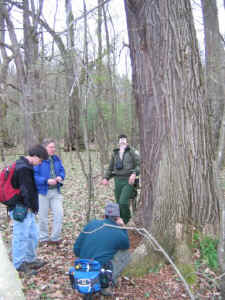 photo by Will Blozan
photo by Will Blozan
Lee
== 2 of 3 ==
Date: Wed, Oct 10 2007 6:02 am
From: "Will Blozan"
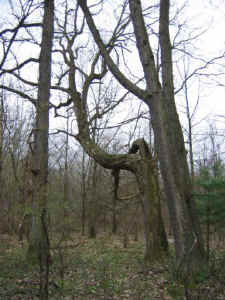 Swamp White Oak - photo by Will Blozan
Swamp White Oak - photo by Will Blozan
Larry,
Here are a few shots from the trip Lee mentions.
|
|